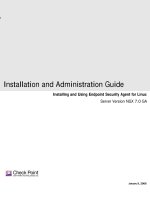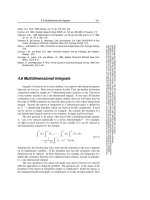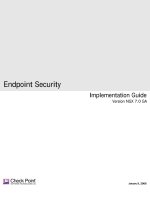Endpoint Security Gateway Integration Guide Version NGX 7.0 GA
Bạn đang xem bản rút gọn của tài liệu. Xem và tải ngay bản đầy đủ của tài liệu tại đây (1.9 MB, 131 trang )
Endpoint Security
January 9, 2008
Gateway Integration Guide
Version NGX 7.0 GA
© 2008 Check Point Software Technologies Ltd.
All rights reserved. This product and related documentation are protected by copyright and distributed under licensing restricting their
use, copying, distribution, and decompilation. No part of this product or related documentation may be reproduced in any form or by
any means without prior written authorization of Check Point. While every precaution has been taken in the preparation of this book,
Check Point assumes no responsibility for errors or omissions. This publication and features described herein are subject to change
without notice.
©2003–2008 Check Point Software Technologies Ltd. All rights reserved. Check Point, AlertAdvisor, Application Intelligence, Check
Point Endpoint Security, Check Point Express, Check Point Express CI, the Check Point logo, ClusterXL, Confidence Indexing,
ConnectControl, Connectra, Connectra Accelerator Card, Cooperative Enforcement, Cooperative Security Alliance, CoreXL, CoSa,
DefenseNet, Dynamic Shielding Architecture, Eventia, Eventia Analyzer, Eventia Reporter, Eventia Suite, FireWall-1, FireWall-1 GX,
FireWall-1 SecureServer, FloodGate-1, Hacker ID, Hybrid Detection Engine, IMsecure, INSPECT, INSPECT XL, Integrity, Integrity
Clientless Security, Integrity SecureClient, InterSpect, IPS-1, IQ Engine, MailSafe, NG, NGX, Open Security Extension, OPSEC,
OSFirewall, Pointsec, Pointsec Mobile, Pointsec PC, Pointsec Protector, Policy Lifecycle Management, Provider-1, PureAdvantage,
PURE Security, the puresecurity logo, Safe@Home, Safe@Office, SecureClient, SecureClient Mobile, SecureKnowledge,
SecurePlatform, SecurePlatform Pro, SecuRemote, SecureServer, SecureUpdate, SecureXL, SecureXL Turbocard, Security
Management Portal, Sentivist, SiteManager-1, SmartCenter, SmartCenter Express, SmartCenter Power, SmartCenter Pro, SmartCenter
UTM, SmartConsole, SmartDashboard, SmartDefense, SmartDefense Advisor, Smarter Security, SmartLSM, SmartMap, SmartPortal,
SmartUpdate, SmartView, SmartView Monitor, SmartView Reporter, SmartView Status, SmartViewTracker, SMP, SMP On-Demand,
SofaWare, SSL Network Extender, Stateful Clustering, TrueVector, Turbocard, UAM, UserAuthority, User-to-Address Mapping, UTM-1,
UTM-1 Edge, UTM-1 Edge Industrial, UTM-1 Total Security, VPN-1, VPN-1 Accelerator Card, VPN-1 Edge, VPN-1 Express, VPN-1
Express CI, VPN-1 Power, VPN-1 Power Multi-core, VPN-1 Power VSX, VPN-1 Pro, VPN-1 SecureClient, VPN-1 SecuRemote, VPN-1
SecureServer, VPN-1 UTM, VPN-1 UTM Edge, VPN-1 VSX, Web Intelligence, ZoneAlarm, ZoneAlarm Anti-Spyware, ZoneAlarm
Antivirus, ZoneAlarm ForceField, ZoneAlarm Internet Security Suite, ZoneAlarm Pro, ZoneAlarm Secure Wireless Router, Zone Labs,
and the Zone Labs logo are trademarks or registered trademarks of Check Point Software Technologies Ltd. or its affiliates. ZoneAlarm
is a Check Point Software Technologies, Inc. Company. All other product names mentioned herein are trademarks or registered
trademarks of their respective owners. The products described in this document are protected by U.S. Patent No. 5,606,668,
5,835,726, 5,987,611, 6,496,935, 6,873,988, 6,850,943, and 7,165,076 and may be protected by other U.S. Patents, foreign
patents, or pending applications.
Endpoint Security Gateway Integration Guide 5
Contents
Preface
About this Guide .................................................................... 10
About the Endpoint Security Documentation Set ....................... 10
Documentation for Administrators ...............................................10
Documentation for Endpoint Users ..............................................11
Feedback ............................................................................... 12
Chapter 1 Gateway Integration Overview
Prerequisites .......................................................................... 13
System Requirements ............................................................. 13
Chapter 2 Network Access Server Integration
Understanding Cooperative Enforcement Architecture ................ 15
Configuration Overview ............................................................ 17
Before You Begin .......................................................................17
Configuring Cooperative Enforcement ..........................................17
Configuring the RADIUS Server ................................................ 18
Configuring the NAS as a RADIUS Client .....................................18
Configuring Endpoint Security as a RADIUS Client .......................19
Configuring Endpoint Security Access to the RADIUS Server .........20
Configuring Endpoint Security ................................................. 23
Enabling 802.1x Communication ................................................23
Creating a Catalog for the Gateway ..............................................23
Assigning a Policy to the Gateway Catalog ....................................23
Configuring the NAS ............................................................... 25
Configuring Endpoint Computers .............................................. 26
Configuring Endpoints for Use with Wireless Access Points ............26
Configuring Endpoints for Use with Wired Connections ..................31
Supported Enforcement Behaviors ........................................... 34
Troubleshooting Your Installation ............................................. 35
General ....................................................................................35
Internet Authentication Service ...................................................35
Endpoint Security ......................................................................35
Endpoint Security client .............................................................35
Network Access Server ...............................................................35
Chapter 3 Check Point VPN-1 Integration
Cooperative Enforcement Using SecureClient and SCV ............... 37
Cooperative Enforcement Workflow ..............................................37
Understanding the SecureClient/Endpoint Security client Unified In-
staller .......................................................................................38
Endpoint Security Gateway Integration Guide Contents 6
System Requirements ............................................................. 39
Configuring VPN-1 to Allow Access to Endpoint Security ............ 40
Integrating the Endpoint Security client with SecureClient ......... 41
Integrating with an Existing SecureClient .....................................41
Integrating with an Existing Endpoint Security client ....................41
Creating a localized unified installation package ...........................42
Configuring your VPN-1Installation ..............................................43
Configuring the SecureClient Installation .....................................46
Checking that the Computer is Securely Configured ......................47
Installing an Endpoint Security client after SecureClient ...............47
Installing SecureClient after the Endpoint Security client ..............48
Checking the Connection ............................................................48
Configuring the SCV Policy ........................................................48
Installing the SCV Policy on Policy Servers ...................................52
Configuring an Endpoint Security client for Use with SecureClient .53
Packaging the Policy File ...........................................................54
Chapter 4 VPN-1 UTM/Power Gateway Integration
Benefits of VPN-1 UTM or Power Gateway Integration ................ 57
System Requirements ............................................................. 57
Configuring the Gateway and Server for Cooperative Enforcement 57
Configuring the Gateway on Endpoint Security Server ....................58
Configuring the Gateway to Use the Endpoint Security Server ........58
Chapter 5 Cisco VPN Concentrator Integration
System Requirements ............................................................. 61
Integrating Cisco VPN 3000 Series Concentrator ....................... 62
Configuring the Cisco Concentrator ..............................................62
Configuring the Endpoint Security client ................................... 65
Overview of client communications ..............................................65
Configuring the Enterprise Policy ................................................66
Packaging the Policy File with Flex or Agent .............................. 70
Troubleshooting ...................................................................... 71
Checking connection to the Endpoint Security Server ....................71
Checking the Log files ................................................................72
Checking the SSL Certificate Exchange .......................................72
Checking the SSL Certificate Validity ...........................................72
Checking the Encryption Type .....................................................73
Checking Port Settings ...............................................................73
Chapter 6 Configuring the Cisco Catalyst 2950
Requirements ........................................................................ 76
Server Requirements ..................................................................76
Client Requirements ..................................................................76
Configuring Cisco Catalyst 2950 G Switch ................................ 77
Configuring the Endpoint Computers ........................................ 80
Endpoint Security Gateway Integration Guide Contents 7
Troubleshooting ...................................................................... 81
Chapter 7 Configuring the Cisco Aironet 1100 Series Wireless Access Point
System Requirements ............................................................. 83
Server Requirements ..................................................................83
Client Requirements ..................................................................83
Configuring Cisco Aironet 1100 Series Wireless Access Point ..... 84
Creating a Cooperative Enforcement SSID ....................................84
Defining a Wired Equivalent Privacy (WEP) Key ............................85
Defining Endpoint Security as the RADIUS Server on the NAS .......85
Setting the Reauthentication Interval ..........................................86
Configuring Endpoint Computers .............................................. 87
Troubleshooting ...................................................................... 88
Chapter 8 Cisco ASA
System Requirements ............................................................. 90
Cooperative Enforcement with ASA .......................................... 91
Workflow ............................................................................... 92
Basic Configuration Tasks ....................................................... 93
Naming and Configuring the Interface .........................................93
Configuring the Server Address ...................................................94
Configuring the Port ...................................................................95
Configuring the Interface Location ..............................................95
Configuring the Timeout Interval .................................................95
Setting the Fail State .................................................................95
Setting the Secure Socket Layer Certificate Options ......................96
Setting the Client Firewall ..........................................................96
Saving ......................................................................................97
Additional Command Line Parameter Reference ........................ 98
clear configure zonelabs-integrity ................................................98
show running-config zonelabs-integrity ........................................98
zonelabs-integrity interface .........................................................99
Chapter 9 Nortel Contivity VPN Switch Integration
Configuring the Nortel Contivity VPN Switch ........................... 101
Enabling Tunnel Filter and Tunnel Management Filter ................101
Creating an Endpoint Security client Software Definition and Tunnel-
Guard Rule .............................................................................103
Creating a Nortel Restricted Access Tunnel Filter to the Endpoint Secu-
rity server Sandbox ..................................................................109
Configuring the Endpoint Security clients ............................... 113
Chapter 10 Configuring the Enterasys RoamAbout R2
System Requirements ........................................................... 117
Server Requirements ................................................................117
Client Requirements ................................................................117
Endpoint Security Gateway Integration Guide Contents 8
Configuring Enterasys RoamAbout R2 .................................... 118
Defining a Wired Equivalent Privacy (WEP) Key ..........................118
Defining Endpoint Security as the RADIUS Server on the NAS .....119
Configuring Endpoint Computers ............................................ 121
Chapter 11 Configuring the Check Point Safe@Office 425W
System Requirements ........................................................... 123
Server Requirements ................................................................123
Client Requirements ................................................................123
Configuring the Safe@Office 425W ........................................ 124
Configuring the Wireless Settings ..............................................124
Defining Endpoint Security as the RADIUS Server on the NAS .....125
Configuring Endpoint Computers ............................................ 127
Endpoint Security Gateway Integration Guide 9
Preface
In This Preface
About this Guide page 10
About the Endpoint Security Documentation Set page 10
Feedback page 12
About this Guide
Endpoint Security Gateway Integration Guide 10
About this Guide
This guide describes the steps necessary to integrate your gateway device with
Endpoint Security. Integrating your gateway with Endpoint Security enables you to use
the Cooperative Enforcement™ feature for remote access protection. Please make sure
you have the most up-to-date version available for the version of Endpoint Security that
you are using.
Before using this document, you should read and understand the information in the
Endpoint Security Administrator Guide in order to familiarize yourself with the
Cooperative Enforcement feature.
About the Endpoint Security Documentation Set
A comprehensive set of documentation is available for Endpoint Security, including the
documentation for the Endpoint Security clients. This includes:
“Documentation for Administrators,” on page 10
“Documentation for Endpoint Users,” on page 11
Documentation for Administrators
The following documentation is intended for use by Endpoint Security administrators.
Table 4-1: Server Documentation for Administrators
Title Description
Endpoint Security Installation
Guide
Contains detailed instructions for installing,
configuring, and maintaining Endpoint
Security. This document is intended for global
administrators.
Endpoint Security Administrator
Guide
Provides background and task-oriented
information about using Endpoint Security. It is
available in both a Multi and Single Domain
version.
Endpoint Security Administrator
Online Help
Contains descriptions of user interface
elements for each Endpoint Security
Administrator Console page, with cross-
references to the associated tasks in the
Endpoint Security Administrator Guide.
Endpoint Security System
Requirements
Contains information on client and server
requirements and supported third party devices
and applications.
Endpoint Security Gateway
Integration Guide
Contains information on integrating your
gateway device with Endpoint Security.
Documentation for Endpoint Users
Endpoint Security Gateway Integration Guide 11
Documentation for Endpoint Users
Although this documentation is written for endpoint users, Administrators should be
familiar with it to help them to understand the Endpoint Security clients and how the
policies they create impact the user experience.
Client Management Guide Contains detailed information on the use of
third party distribution methods and command
line parameters.
Endpoint Security Agent for Linux
Installation and Configuration
Guide
Contains information on how to install and
configure Endpoint Security Agent for Linux.
Table 4-1: Server Documentation for Administrators
Title Description
Table 4-2: Client documentation for endpoint users
Title Description
User Guide for Endpoint Security
Client Software
Provides task-oriented information about the
clients (Agent and Flex) as well as information
about the user interface.
Introduction to Flex Provides basic information to familiarize new
users with Flex. This document is intended to
be customized by an Administrator before
distribution. See the Endpoint Security
Implementation Guide for more information.
Introduction to Agent Provides basic information to familiarize new
users with Agent. This document is intended to
be customized by an Administrator before
distribution. See the Endpoint Security
Implementation Guide for more information.
Feedback
Endpoint Security Gateway Integration Guide 12
Feedback
Check Point is engaged in a continuous effort to improve its documentation. Please
help us by sending your comments to:
Chapter
Endpoint Security Gateway Integration Guide 13
1
Gateway Integration Overview
In This Chapter
This book describes the steps necessary to integrate your gateway device with Endpoint
Security. Integrating your gateway with Endpoint Security enables you to use the Cooperative
Enforcement™ feature for remote access protection.
Prerequisites
This book only describes the integration steps specific to each gateway device. You must also
perform the steps for configuring the Cooperative Enforcement feature as described in the
Endpoint Security Administrator Guide. You should read the chapter on Cooperative
Enforcement in the Endpoint Security Administrator Guide before proceeding with any of the
steps in this guide. You will also need to have a general understanding of networking
concepts. It is recommended that you have your gateway already configured to work with your
network before beginning and that you have tested your setup.
System Requirements
For all system requirements and version information for supported gateways, see the
Endpoint Security System Requirements document.
Prerequisites page 13
System Requirements page 13
Chapter
Endpoint Security Gateway Integration Guide 14
2
Network Access Server Integration
In This Chapter
This chapter describes how to set up Endpoint Security’s Cooperative Enforcement feature for
an 802.1x-compatible network access server (NAS). To enable Cooperative Enforcement, you
must configure the:
RADIUS server
Endpoint Security
802.1x-compatible NAS
endpoint computer
This chapter covers configuration of the RADIUS server, the Endpoint Security server, and the
endpoint computer. For information about configuring your NAS, see the appropriate
vendor-specific chapter. (Vendor-specific chapters are listed in “Configuring the NAS,” on
page 25.)
The instructions in this chapter assume you have already installed and performed the initial
configuration on a supported NAS and a supported RADIUS server.
Understanding Cooperative Enforcement Architecture page 15
Configuration Overview page 17
Configuring the RADIUS Server page 18
Configuring Endpoint Security page 23
Configuring the NAS page 25
Configuring Endpoint Computers page 26
Supported Enforcement Behaviors page 34
Troubleshooting Your Installation page 35
Understanding Cooperative Enforcement Architecture
Endpoint Security Gateway Integration Guide 15
Understanding Cooperative Enforcement
Architecture
The Cooperative Enforcement system architecture allows for a variety of different
configurations. This section describes how the components interact to provide
cooperative enforcement.
1 A user opens a connection to the NAS.
2 The NAS directs the connection to Endpoint Security.
3 Endpoint Security forwards the authentication request to the RADIUS server.
4 If authentication
a succeeds, Endpoint Security can communicate with the endpoint computer.
bfails, the connection terminates.
5 Endpoint Security checks the endpoint computer’s compliance. If the client is
NAS
Endpoint Se-
curity server
User initiates
connection
RADIUS
authenticates
Endpoint Se-
curity
validates
User allowed
into network
User restricted
Connection
terminates
Authentication succeeds
Authentication
Validation succeeds
Validation fails
Understanding Cooperative Enforcement Architecture
Endpoint Security Gateway Integration Guide 16
a compliant, the client is granted access to the corporate network.
b not compliant, the client is restricted to an isolated Virtual Local Area Network
(VLAN) or to the Sandbox, or traffic is limited to specific destination IP
addresses, ports, and protocols. You can also configure Endpoint Security to
reject connections for non-compliant endpoints that attempt to connect to the
network through a wireless access point (as opposed to a switch). (For
information about rejecting the connection, see the sections on gateway catalogs
in the Endpoint Security Administrator Guide and the associated online help. For
more information about the Sandbox, see the Installation and Configuration
Guide.)
Endpoints may not have enough time, when restricted, to download the client
package over an 802.11B wireless access point. If you are using an 802.11B
wireless access point, your endpoints may need to be attached to a wired LAN
to download the client package file.
Use an 802.11G device or have endpoints connect using a wired LAN
to get the client package.
Configuration Overview
Endpoint Security Gateway Integration Guide 17
Configuration Overview
This section discusses the information you will need before starting the configuration,
and it lists the necessary configuration procedures.
Before You Begin
Before you begin, gather the following information for each NAS-type / RADIUS
combination in your system:
Port and IP Address for:
Endpoint Security
RADIUS server or distributed RADIUS proxy server
RADIUS shared secret
NAS shared secret
NAS IP address
VLAN ID and Filter name (depending on NAS support)
Any vendor-specific attributes (VSAs) for your NAS
Configuring Cooperative Enforcement
This section lists the procedures you must perform to enable Cooperative Enforcement.
The individual procedures are covered in the sections that follow.
To configure Cooperative Enforcement with an 802.1x-compatible
NAS:
1 Configure the RADIUS server. See page 18.
a Configure the NAS as a RADIUS client. See page 18.
b Configure Endpoint Security as a RADIUS client. See page 19.
c Configure Endpoint Security access to the RADIUS server. See page 20.
2 Configure Endpoint Security. See page 23.
a Enable 802.1x communication. See page 23.
b Create a catalog for the gateway. See page 23.
c Assign a policy to the gateway catalog. See page 23.
3 Configure the NAS. See page 25.
4 Configure the endpoint computer. See page 26.
Configuring the RADIUS Server
Endpoint Security Gateway Integration Guide 18
Configuring the RADIUS Server
This section explains how to configure the RADIUS server. Perform these steps for
each NAS that proxies authentication to the RADIUS server.
To configure the Internet Authentication Service:
1 Configure the NAS as a RADIUS client. See page 18.
2 Configure Endpoint Security as a RADIUS client. See page 19.
3 Configure Endpoint Security access to the RADIUS server. See page 20.
Configuring the NAS as a RADIUS Client
On the RADIUS server, configure the NAS as a RADIUS client.
The examples in this section use Microsoft’s Internet Authentication Service. If you are using
a RADIUS server other than the Internet Authentication Service, consult your product
documentation for instructions on adding a RADIUS client.
Configuring Endpoint Security as a RADIUS Client
Endpoint Security Gateway Integration Guide 19
To add the NAS as a RADIUS client:
1 Open Internet Authentication Service, expand RADIUS clients, and choose New
RADIUS Client.
The New RADIUS Client window opens. Enter the new RADIUS client information as
follows:
a In the Friendly name field, enter the friendly name for the NAS.
b In the Client address (IP or DNS) field, enter the IP address of the NAS.
2 Click Next.
The Additional Information window opens.
3 Enter the RADIUS shared secret, re-enter the secret in the confirmation box, and
click Finish.
The NAS appears in the RADIUS client list.
4 Verify the configuration by right-clicking the NAS RADIUS client entry and choosing
Properties.
Configuring Endpoint Security as a RADIUS
Client
Endpoint Security handles authentication requests to the RADIUS server.
Configuring Endpoint Security Access to the RADIUS
Endpoint Security Gateway Integration Guide 20
To add Endpoint Security as a RADIUS client:
1 Open Internet Authentication Service, expand RADIUS clients, and choose New
RADIUS Client.
The New RADIUS Client window opens.
2 Enter the client information as follows:
a In the Friendly name field, enter Integrity Advanced Server.
b In the Client address (IP or DNS) field, enter the IP address of Endpoint Security.
3 Click Next.
The Additional Information window opens.
4 Enter the RADIUS shared secret, re-enter the secret in the confirmation box, and
click Finish.
Endpoint Security appears in the RADIUS client list.
5 Verify the configuration by right-clicking the Endpoint Security RADIUS client entry
and choosing Properties.
Configuring Endpoint Security Access to the
RADIUS Server
To configure Endpoint Security access to the RADIUS server:
1 In the Internet Authentication Service left panel, select Remote Access Policies.
The Remote Access Policies appear in the right panel.
Make note of the RADIUS secret you enter for the client, as you must enter the same secret
when configuring the gateway on the Endpoint Security server.
Configuring Endpoint Security Access to the RADIUS
Endpoint Security Gateway Integration Guide 21
2 Right-click Connections to Microsoft Routing and Remote Access server and choose
Properties.
The Wireless Properties window appears.
3 In the Policy Conditions area, set the conditions that are appropriate for your
organization. (The example above shows the default setting.)
4 Select Grant remote access permission and click Edit Profile.
The Edit Dial-in Profile window opens.
5 Select the following settings from the Authentication tab:
Microsoft Encrypted Authentication version 2 (802.1x)
User can change password after it has expired
Microsoft Encrypted Authentication (MS-CHAP)
User can change password after it has expired
Configuring Endpoint Security Access to the RADIUS
Endpoint Security Gateway Integration Guide 22
6 Click EAP Methods.
A list of the EAP types that are configured with the policy appears.
7 Remove all EAP types except the one you plan to use. (You can only specify one EAP
type per NAS.)
8 Click OK to save your changes. Click OK in each window to close all except the main
Internet Authentication Service window.
9 Restart the Internet Authentication Service to register the new configuration. To do
so, right-click Internet Authentication Service (in the left panel) and choose stop,
and then right-click it again and choose start.
10Right-click Internet Authentication Service (local) and select Register Server in
Active Directory. IAS can now authenticate users from your AD domain.
Configuring Endpoint Security
Endpoint Security Gateway Integration Guide 23
Configuring Endpoint Security
This section describes how to configure Endpoint Security to work with an
802.1x-compatible NAS.
To configure theEndpoint Security server:
1 Enable 802.1x communication. See page 23.
2 Create a catalog for the gateway. See page 23.
3 Assign a policy to the gateway catalog. See page 23.
Enabling 802.1x Communication
To enable 802.1x communication:
1 In the Endpoint Security administration console, go to System Configuration | Server
Settings | Edit. (If your Endpoint Security installation has multiple domains, do this
in the System Domain.)
2 Under 802.1x Settings, select Configure Settings for Enabling 802.1x.
3 Type the RADIUS authentication port number and the RADIUS secret.
4 Click Save.
Creating a Catalog for the Gateway
Create a gateway catalog for your NAS. This lets you apply a specific policy to all users
who access the network through that NAS. For information about creating a gateway
catalog, see the Endpoint Security Administrator Guide and the associated online help.
Assigning a Policy to the Gateway Catalog
Assign a policy to your new gateway catalog. Users who log in through the relevant NAS
will receive the assigned policy. For information about creating and assigning policies,
see the Endpoint Security Administrator Guide.
Assigning a Policy to the Gateway Catalog
Endpoint Security Gateway Integration Guide 24
If you are using Cooperative Enforcement, it is recommended that you not set any
Restriction Firewall Rules in the Enforcement Rules of you policy. Using Cooperative
Enforcement and Restriction Firewall Rules simultaneously makes it difficult to
troubleshoot your configuration.
If you must use Restriction Firewall Rules in your policy, it is recommended that you begin
with a policy that has no Restriction firewall rules and then, with each successive policy,
add only one rule. After you deploy each policy you should carefully observe the results
before adding another rule.
For more information about Restriction Firewall Rules, see the Endpoint Security
Administrator Guide.
Configuring the NAS
Endpoint Security Gateway Integration Guide 25
Configuring the NAS
After configuring the RADIUS server and Endpoint Security according to the
instructions in this chapter, you must configure the NAS and the endpoint computers.
To configure the NAS, see the appropriate vendor-specific chapter:
“Configuring the Cisco Aironet 1100 Series Wireless Access Point,” on page 82
“Configuring the Cisco Catalyst 2950,” on page 75
“Configuring the Enterasys RoamAbout R2,” on page 116
“Configuring the Check Point Safe@Office 425W,” on page 122
After you configure the NAS, return to this chapter and configure the endpoint
computers as described in the next section.
Be sure to set the reauthentication intervals on all switches and wireless access points to
five minutes or more.









